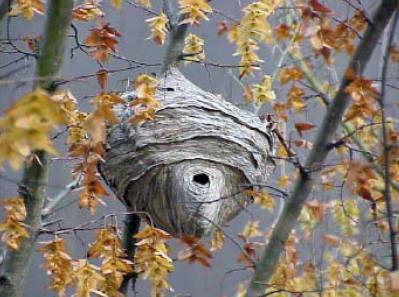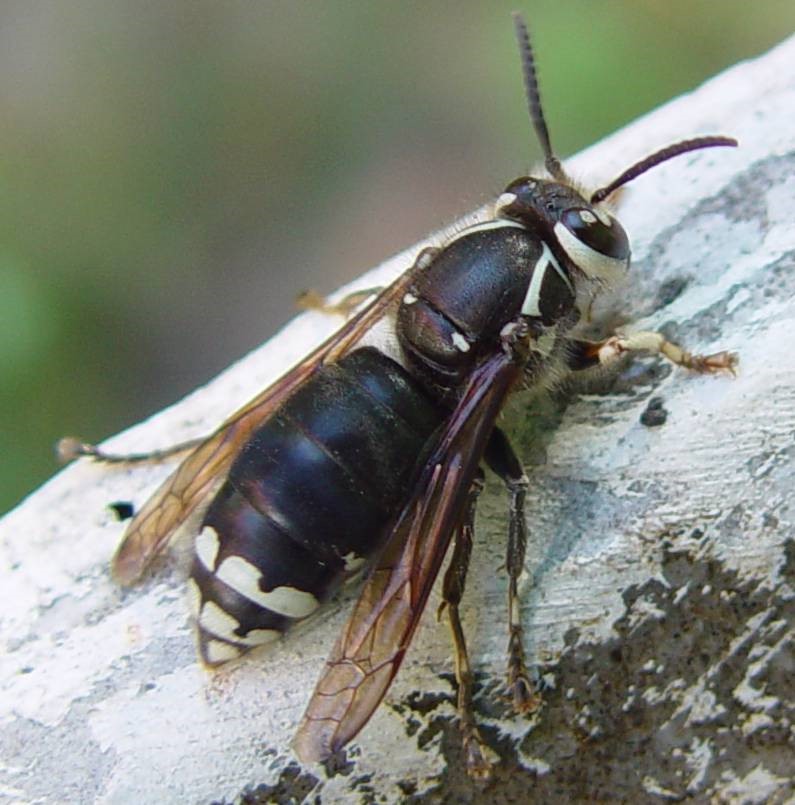
Serving Southwest Ohio and Northern Kentucky

info@TheBugBusters.net.
Attention Realtors and Loan Officers: Click the link for our online inspection sheet.
About Bald Faced Hornets
Known for their large nests and aggressive nature, baldfaced hornets are an impressive and often misunderstood member of the wasp family. Contrary to the name, the baldfaced hornet is not a hornet. It is one of the many types of yellowjackets found in the United States. The baldfaced hornet is often confused with a similar-sized wasp, the European hornet, which is the only true hornet in North America. In nature, baldfaced hornets are extremely valuable because they kill many pests including flies, caterpillars, and spiders. It is only when their nests are near areas of human activity that they pose a threat to people.
Appearance
Baldfaced hornets are different from other yellowjackets because of their white-and-black color as opposed to the more typical yellow-and-black pattern. The most notable feature of this wasp is the white or “bald face” head. They also have three white stripes on the end of their body. Compared to other yellowjackets, baldfaced hornets are extremely large. Adult workers vary in size, but average about 3/4 inch long. Queens look like the workers and are a little larger.
Habits
Their nests consist of one queen and many female workers. During early spring (April-June) mated queens emerge from protected sites, such as stumps, logs, and under loose bark.
Once she finds a suitable location, a queen begins construction of a paper nest, lays eggs, and collects prey to feed her growing young. After the first generation completes development and emerge as winged adults, they assume the duties of building and maintaining the nest, and foraging for food, water, and care for the colony. Colonies often average about 400 workers but can vary in size from 100-700. In early July to September, new queens and males are produced. The males and queens will leave the nest mate and the new queens will find a suitable protected site to overwinter (semi hibernate). The original queen and workers die after the males and future queens leave the nest. In most cases, abandoned nests are not reused and often decompose during the winter. Nests that have been reused have only been seen in more tropical areas of North America.
Baldfaced hornet nests often hang in trees and shrubs where they go unnoticed until the leaves have dropped in the fall. Nests can also be built on eves of buildings, on windows, in attics or on other artificial structures. They are often pear or egg-shaped and can be as large as 14 inches in diameter and over 23 inches in length. Nests are constructed of multiple layers of hexagonal combs, similar in shape to those of honeybee nests and covered in a mottled gray paper envelope. The raw materials for the “paper” are from vegetable fibers, such as rotten or weathered wood, dead plants, or even man-made materials such as cardboard and newspaper. The fibers are chewed and mixed with saliva to make a pulp which is then formed into place.
The sting of a Baldfaced hornet is like those of most other social bees and wasps. A typical reaction includes immediate pain and/or swelling. Other sensations may include burning and itching. For some individuals, the initial swelling may be painful and increase to affect a larger area. One unique behavior of baldfaced hornets is the ability to squirt venom from the stinger into the eyes of nest intruders. The venom causes immediate watering of the eyes and temporary blindness.
Most social wasps vigorously defend their nests from perceived threats. Baldfaced hornets are known for their aggressive behavior. People are often stung when they accidentally stumble upon a hidden nest or when the nest is in areas adjacent to homes or places where there is human activity.
It is strongly suggested that you do not attempt to eliminate Baldfaced Hornets yourself. They are extremely aggressive and can pose great danger.
Common characteristics of Baldfaced Hornets in our area:
They are extremely aggressive.
Size: ¾ inch long, queens slightly larger. Color: white-and-black
Nest/hive:

Adult hornet:

Dayton, OH 45401-3151
Phone 937-256-6475
info@TheBugBusters.net
Powered by w3.css